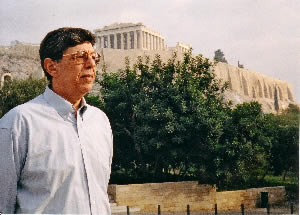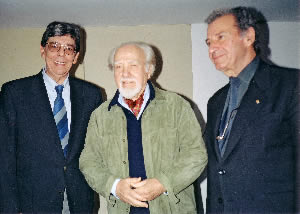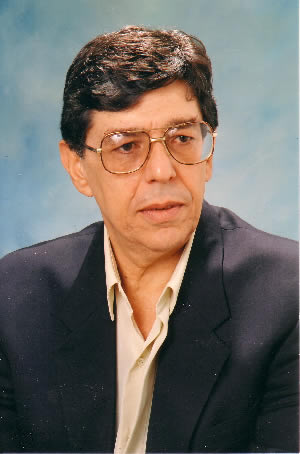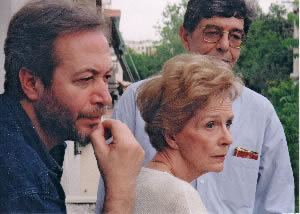A transcendental
musical travelogue, Jesus Christ’s steps towards His Passion and
Resurrection. A Byzantine hum of the diachronic presence of the Greek
Nation, conveying a message, which addresses to all races and to
all human beings.
A unique artistic
encounter of East and West : The Orchestre Francais d’Oratorio
( O.F.O. ) in a contemporary, singular and elaborate performance
accompanied by Greek Traditional Instruments. The
French Chorus Ensemble Vocal de la Cite in a glorious
monophonic unison with a Greek Chorus.
Excellent
performances by eminent Greek and foreign actors and solists. A
rare recording, realised in Athens and
in Paris.
An original feast
of music, which lasts for four hours, packed in a luxurious case
consisting of 3 cd’s and a detailed insert booklet in four languages
with extended informative and photographic material.
BYZANTINE MUSIC AND THE OPUS
Among the orthodox peoples who inherited the inexhaustible cultural
treasure of the medieval eastern empire, it is the Greeks who have had
to carry the overwhelming burden of authority on Language, Art and Music.
Byzantine music, music of Eastern Orthodox Church, is a superb fusion
of ancient Greek elements and Eastern influences.
As Music of the Chant, Byzantine Music is a melodic treasure trove of
intensity of expression bear witness to a high level of musical culture.
Although monophonic, it boasts of such a variety of scales and modes
and is so rich in vocal glides and idioms that it can render to the full
the spirit and the sensibility of the passages interpreted though its
notes.
Typical for the performance of a Byzantine melody of hymn, is the constant
presence of the vocal drone, i.e. one or more voices intoning a steady
note whose pitch follows the movements of the melody ensuring the harmonization
of the chant.
In CRUCIFIXION the role of the vocal drone is played by instrumental
ensembles, only occasionally combined with vocals, thus achieving a chromatically
firmer and mellower sound. This type of instrumental drone is an integral
part of the instrumental-orchestral accompaniment of the interpretation
of the hymns.
In Byzantine music, by the term apechema we mean a short musical phrase
preceding the chant and serving as an introduction to the scale or family
of scales the chant belongs to.
Therefore, the orchestral overtures to the parts of CRUCIFIXION are compositions
on the scale of the chant that is going to follow, that is compositions
based on an analysis of the apechema. Besides being introductory to the
scale of the chant, these compositions also help introduce the audience
to the atmosphere and the spirit of the passage that is going to be heard
immediately afterwards.
The various parts of the performance of the opus are punctuated by a
number of orchestral or solo musical phrases signaling a scale shift,
that serves both as a conclusion of the previous chant, as well as an
introduction to the one following.
The development of these phrases uses as stepping stones the successive
notes of a tetrachord in order to ease the transition from scale to scale,
from scale family to scale family or even from tetrachord to tetrachord
of the same scale. It is obvious that this transition is lost in the
case of a purely vocal interpretation.
Byzantine music is particularly aware of stress and intonation in natural
speech since it is this speech it is called upon to accentuate and serve
par excellence. This musical emphasis on grammatically stressed syllables
commands the use of percussion and special sounds making these syllables
more prominent.
“The use of an orchestra of strings and traditional instruments gave
me the opportunity to rely on Byzantine notes and scales in order to
express my feelings about the Holy Passion and the Resurrection never
for once backtracking from being overshadowed by any orchestral accompaniment,
should on the contrary be stressed and exalted”.
The opera CRUCIFIXION is purely Byzantine in style, yet it attempts to
innovate the genre by incorporating traditional, symphonic and rock elements.
It covers the period from Palm Sunday and consists of 3 parts: Entry
(Palm Sunday, Monday through Wednesday), Sacrifice (Wednesday, Thursday,
Good Friday), Redemption (Good Friday, Saturday, Easter Sunday).
Orchestral ensembles, choirs, instrumental and vocal solos and dramatic
dialogue interpreted by well-known actors and actresses might classify
the opus as belonging to the Western musical tradition. The opera, however,
is permeated by the spirit of the East; the choice of Greek Orthodox
hymns, the chanting, the plaintive lament, the bitterness and the sorrow,
the sacrifice for love, exquisitely expressed in the culture of the East,
endow it with the unmistakably Byzantine identity of the Greek East.
He opera sets out to explore the common ground between East and West,
ceding, however, precedence to the former as it credits it with giving
the world love in its most absolute and extreme form: votive love, capable
of reaching the point of total sacrifice and triumph.
Christ’s steps towards passion and his eventual resurrection are a story
of Love in the Greek sense of the word. This is why CRUCIFIXION is a
genuinely Greek opus and it is in this context that Dionysios Solomos,
the Greek National Anthem, based on his poem Hymn to Liberty, being the
anthem of Greece as a universal entity, independent of physical borders
(National is whatever is true, wrote Solomos) is sung in the finale along
with the Hymn to the Resurrection (Christos Anesti), a symbol of redemption
and of the triumph of Love.
I
N D E X
I
S O D O S (E n t r y)
| 1. |
INTRODUCTION-RECITATION
(voice:
Yannis Boufidis) |
10. |
SEMI
IMPROVISATION
with
flute (diatonic scale) (solo : Ph. Tseberoulis) |
| 2. |
HOLY
WEEK
orchestral
part |
11. |
LORD,
AS YOU WEREAPPROACHING YOUR PASSION
(voice:
Y. Boufidis-Gr. Valtinos) |
| 3. |
SEMI
IMPROVISATION
with
oud (chromatic scale) |
12. |
RECITATION
(Voice:
R. Avgeri)Semi
Improvisation with kanonaki(whole-tone
scale)
(solo: A. Apergis) |
| 4. |
SIX
DAYS BEFORE THE PASSOVER
(voice:
Y. Boufidis-H.Lamy) |
13. |
I
SEE YOUR BRIDAL CHAMBER
(Voice:
N. Weinberg) |
| 5. |
SEMI
IMPROVISATION
with
clarin (diatonic scale)
(solo:
Ph. Tseberoulis) |
14. |
WOMAN
SINNER
(voice:
Y. Boufidis-J. Drivala) |
| 6. |
CHANTING
RECITATION
(voice:
J. Modenos) |
15. |
SEMI
IMPROVISATION
with
flute (chromatic scale)
(solo:
Ph. Tseberoulis) |
| 7. |
HALLELUJAH-BEHOLDTHE BRIDEGROOM
(voice:
Gr. Valtinos-N.
Weinberg |
16. |
THE
PROSTITUTE WEEPING
(voice:
H. Lammy-J. Drivala) |
| 8. |
NARRATION
(voice:
O. Tournaki)
Semi
Improvisation with violin
(chromatic
scale)
(solo: S. Kyriazopoulos) |
17. |
LORD,
I WHO COMMITTED SO
MANY SINS
(Kassiani’s
troparion)
(voice:
J. Drivala-Gr. Valtinos) |
| 9. |
THE
HOLY PASSION
(voice:
M. Sondaki) |
18. |
WHEN
THE ILLUSTRIOUS DISCIPLES
(voice:
N. Weinberg) |
T
H Y S I A (S a c r i f i c e)
|
1. |
LAST
SUPPER
orchestral
part
(diatonic and whole-tone scale)
(voice:
O. Tournaki-Gr. Valtinos) |
12. |
CHANTING
RECITATION
(voice:
J. Modenos) |
| 2. |
ILLEGAL
COUNCIL, SAVIOUR
(voice:
N. Weinberg-Y. Boufidis) |
13. |
TODAY
HE IS HANGED
(voice:
Y. Boufidis) |
| 3. |
SEMI
IMPROVISATION
with
oud (diatonic scale)
(solo:
Christos Zervas) |
14. |
RECITATION
(voice:
R. Avgeri)
Semi
Improvisation with clarin
(chromatic
scale)
(solo:
Ph. Tseberoulis) |
| 4. |
TODAY
JUDAS
(voice:
Y. Boufidis) |
15. |
THE
THIEF
(voice:
N. Weinberg) |
| 5. |
SEMI
IMPROVISATION
with
flute and sazi
(chromatic scale)
(solo:
Ph. Tseberoulis) |
16. |
THE
VIRGIN MARY SEEING YOU ON THE CROSS
(voice:
O. Tournaki-H. Lamy-M. Sondaki) |
|
6. |
THEY
STRIPPED ME
(voice:
Gr. Valtinos) |
17. |
NOBLE
JOSEPH
(voice:
M. Polykandrioti) |
|
7. |
NARRATION
(voice:
O. Tournaki) |
18. |
NARRATION
(voice:
O. Tournaki) |
|
8. |
SEMI
IMPROVISATION
with
kanonaki
(diatonic scale)
(voice:
Gr. Valtinos-solo: A. Apergis) |
19. |
WHEN
JOSEPH TOOK YOU DOWN FROM THE CROSS
(voice:
H. Lamy-J. Modenos) |
|
9. |
BLESSINGS
(voice:
J. Drivala-H. Lammy) |
20. |
GOSPEL
(voice:
Y. Boufidis) |
| 10. |
RECITATION
(voice:
Gr. Valtinos) |
21. |
DIRGE
(chromatic
scale)
(voice:
J. Drivala) |
| 11. |
CRUCIFIIXON
(voice:
M. Sondaki-Gr. Valtinos) |
|
|
L
Y T R O S I (R e d e m p t i o n)
| 1. |
ENCOMIUMS
(voice:
M. Sondaki-J. Drivala-H.
Lamy-J.
Modenos-O. Tournaki) |
10. |
GOSPEL:
“Then the same day…”
(voice:
+ G. Skoutelis) |
| 2. |
AT
THE SEPULCHRE
(voice:
Y. Boufidis-J. Drivala) |
11. |
RECITATION
(voice:
O. Tournaki) |
| 3. |
GLORIFY
THE LORD, OH MY SOUL
(voice:
Hyun Ok Lee-N. Weinberg) |
12. |
CHRIST
IS RISEN
(voice:
+ I. Batach) |
| 4. |
EASTERN
CANON
(voice:
R. Avgeri) |
13. |
GOSPEL:
:Then
the same day…”
(voice: I. Batach) |
| 5. |
GOSPEL:
“Then the same day…”
(voice:
H. Lamy) |
14. |
NARRATION
(voice:
O. Tournaki-Gr. Valtinos) |
| 6. |
THE
ANGEL CRIED OUT
(voice:
Y. Boufidis-M. Sondaki) |
15. |
BYZANTINE
8 SCALE
orchestral
execution |
| 7. |
GOLPEL:
“Then the same day…”
(voice:
M. Phoenix) |
16. |
SEMI
IMPROVISATION
with
kanonaki (diatonic scale)(solo:
A. Apergis) |
| 8. |
HOLY
EASTER-THE WOMEN BEARING MYRRH
(voice:
J. Modenos-Y. Boufidis-Gr. Valtinos) |
17. |
HYMN
TO LIBERTY (THE
GREEK NATIONAL ANTHEM)- CHRIST
IS RISEN
orchestral
- choral part |
| 9. |
GLORY-RESURRECTION
DAY
(voice:
Gr. Valtinos) |
|
|


|
SOCRATES
399 b.C.
TIME TO GO
ORATORIO
by YANNIS
BOUFIDIS
from
the philosophical tragedy by the same title
by KOSTAS
E. BEYS
|
|
For
a long time now I have felt the inclination to set to music
the wonderful world of Ancient Greece and contribute to
its promotion to the world. (…)
…Philosophy…
grandest music’ and the mature words of Kostas filled my
thoughts with onus, my soul with music and the staves with
notes. The quest for aesthetics is naturally a fascinating
adventure: the words without metre led me to write uneven
bars and stresses. The philosophical expression led me
to use Byzantine scales, harmonising eastern and western
forms, with occasional melodical Byzantine themes supported
by harmonic quartets. The oratorical structure led to the
composite and orchestral formulation of the overtures as
well as defining the choreography of the vocal soloists
and narrators.
The
composer |
|
|
NARRATORS – VOCAL SOLOISTS
LYCOURGOS KALLERGIS |
|
Socrates |
GREGORIS VALTINOS |
|
Hermogenes |
KOSTAS BEYS |
|
Phaedo |
GINA FOTINOPOULOU |
|
Diotima |
KOSTIS KONSTANTARAS |
|
Crito |
SOPHIA KAPETANAKOU |
|
Hera |
GEORGE FANARAS |
|
Apollodorus |
TRADITIONAL INSTRUMENTS SOLOISTS
PHILIPPOS TSEMPEROULIS |
|
Flute - Clarine |
THANOS GIOULETZIS |
|
Violin |
SOCRATES SINOPOULOS |
|
Lyre |
MANOLIS PAPPOS |
|
Oud – Lute |
MANOS KOUTSAGELIDIS |
|
Kanonaki |
ANDREAS PAPPAS |
|
Percussion |
KOSTAS NIKOLOPOULOS |
|
Guitars |
CHRISTOS KALOUDIS |
|
Horn |
STRING
ENSEMBLE
ARMONIA
CHOIR
FONS
MUSICALIS
(Dir:
Kostis Konstantaras)
COMPOSITION
- ORCHESTRATION - HARMONIZATION - DIRECTION
YANNIS
BOUFIDIS
_____________________
I
N D E X
PART
1 |
PART
2 |
1.
INTRODUCTION
Orchestral part |
1.
IN THE PANATHENAEON STREET Orchestral part |
2.
SEMI IMPROVISATION
with flute
Narration:
L. Kallergis |
2.
WHEN THE COMEDY BECOMES A TRAGEDY
semi improvisation with
horn
Narration: Gr.Valtinos, L.Kallergis
Voice:
K.Konstantaras, S.Kapetanakou |
3.
THE SPIRITUAL DIMENSION OF THE DIVINE Semi
improvisation with horn
Voice:
G.Fotinopoulou, K.Konstantaras
S.Kapetanakou, G.Fanaras
Narration: L.Kallergis, Gr.Valtinos |
3.
HOPING FOR LIFE ETERNAL
semi improvisation with lyre
Narration: L.Kallergis, Gr.Valtinos, K.Beys
Voice: G.Fanaras,
G.Fotinopoulou |
4. THE
PHILOSOPHER HAS NO FEAR
Semi improvisation
with kanonaki
Narration:
L.Kallergis, Gr.Valtinos
Voice: G.Fotinopoulou |
4.
AND CALMLY HE DRANK THE HEMLOCK
semi improvisation with lyre
Narration: Gr.Valtinos
Voice: S.Kapetanakou, G.Fanaras |
5. THE
INSECURITY OF THE FEARFUL
Semi improvisation
with kanonaki
Voice:
S.Kapetanakou, G.Fanaras
Narration: L.Kallergis, G.Valtinos |
5.
HE CROSSED OVER TO ETERNITY
semi improvisation
with lyre |
6.
SEMI IMPROVISATION
with
clarin-flute-lyre |
6.
IT’ S OVER
semi improvisation with violin
Narration: Gr.Valtinos
Voice: Gr.Valtinos |
7.
PROFESSIONS ABOUT THE CHARACTER OF THE PHILOSOPHER
Semi
improvisation with kanonaki
Voice: G.Fanaras Narration: L.Kallergis |
|
8.
THE CRIME OF THE INTELLECTUAL
Semi improvisation
with kanonaki
Narration: L.Kallergis,
Gr.Valtinos
Voice: G.Fotinopoulou |
|
9.
SEMI IMPROVISATION
with horns |
|
10.
THE CHARACTER OF A FAIR JUDGE
Narration: L.Kallergis,
Gr.Valtinos
Voice: K.Konstantaras |
|
|
ODE
TO
CONSTANTINE
PALAEOLOGUS
by YANNIS BOUFIDIS
Texts-Lyrics: IRENE GALANOU
|
MYSTRAS
- CONSTANTINOPLE
…It was
through a similar process that Constantine Palaeologus,
a symbol in the collective conscience of our nation,
sprang up in my score. I followed his footsteps from
Mystras to Constantinople until his honorable death
in front of St. Romanus’ gate. Along with a whole nation
that had to live through the ultimate ordeal. As it
had to move through history, legend and tradition,
this musical accompaniment of mine did not even attempt
to fit into a unified compositional and stylistic mould.
Epic poetry coexists with dirges, Byzantine hymns with
western scores, and the music accompanying the hymns
is of a solemnity appropriate to their liturgical environment.
What really mattered throughout this experience was
the myrrh of the free soul, the Phoenix that emerges
from the ashes. The spirit that transforms a national
calamity into an epic. The epic of the Final Fall.
The composer |
|
The gradual decline and territorial shrinking
of the Byzantine Empire made Constantinople, Capital of the Ecumene for
1100 years, vulnerable to the new danger that threatened its very existence.
The Principality (Despotate) of Mystras, important political and cultural
center of the Byzantine period, with close links to Constantinople, became
a rallying point and a refuge for artists, scholars and philosophers.
On 6 January 1449 the Despot of Mystras,
Constantine Dragases Palaeologus, was crowned Emperor of Byzantium at the
Mystras Cathedral of St Demetrius. With three Catalan galleys accompanied
by a Byzantine chelandion the
Emperor and his retinue sailed from Gytheon to Constantinople determined
to fight to the end for its salvation. Despite the removal of the dogmatic
rift between the churches proclaimed by the Emperor in defiance of all
internal reaction and despite promises to the contrary, the City of Cities
did not receive any help from the Christian world either of the West or
of the East. After 57 days of siege under relentless cannon fire, days
of pain and awe, Constantinople fell to the Ottomans on 29 May 1453.
The ethical stature of its tragic defenders, their sacrifice and the honourable
death of the last Emperor Constantine 11th Palaeologus became a symbol
in the collective conscience of the Nation. A landmark in the recent history
of Hellenism.
NARRATORES - VOCAL SOLOISTS
| |
Constantine Palaeologus |
ANTIGONI
VALAKOU |
Narrator-Constantinople |
SOPHIA
KAPETANAKOU |
Sophia |
GINA FOTINOPOULOU |
Athanasia |
KAITI
KOULLIA |
Theodosia |
GEORGE
FANARAS |
Georgios |
IRENE
ZOI |
Irini |
YANNIS
BOUFIDIS |
Ioannis |
TRADITIONAL INSTRUMENTS SOLOISTS
| PHILIPPOS TSEBEROULIS |
Flute-Clarinet-Recorder |
THANOS GIOULETZIS |
Violin |
SOCRATES SINOPOULOS |
Lyre |
MANOLIS PAPPOS |
Oud-Lute |
MANOS KOUTSAGELIDIS |
Zither |
ANDREAS PAPPAS |
Percussion |
NESTORAS DROUGAS |
Percussion |
STRING ENSEMBLE
ARMONIA
(Leader: Pantelis Despotidis)
CHOIR ENSEMBLES
FONS
MUSICALIS
(Director: Kostis Konstantaras)
NATIONAL CONSERVATORY CHOIR
(Director: Spyros Klapsis)
COMPOSITION
ORCHESTRATION - HARMONIZATION - DIRECTION
YANNIS BOUFIDIS
ORGANIZATION - PRODUCTION
OKTOECHOS
________________
I N D E X
PART
I – MYSTRAS |
PART
II - CONSTANTINOPLE |
| 1. |
MORNING TUNE
Voice: G. Valtinos
Semi improvisation on the clarinet
LACONIAN LAND
Narration: A. Valakou
Voice: Choir |
2. |
MYSTRAS (song)
Voice: I. Zoi, Choir |
3. |
SEMI IMPROVISATION on
the clarinet
Narration: A. Valakou, G. Valtinos |
4. |
LONG LIVE THE KING
Narration: A. Valakou
Voice: Choir |
5. |
PSALM Κ’
Narration: A. Valakou
Voice: G. Fanaras, S. Kapetanakou, Choir |
6. |
MANY SHALL BE THE YEARS
Voice: S. Kapetanakou, Choir |
7. |
LORD, SAVE YOUR PEOPLE
Voice: Choir |
8. |
JOYOUS LIGHT
Voice: G. Valtinos, Choir
|
9. |
OH LORD, GRANT
Narration: A. Valakou |
10. |
LACONIAN LAND
(song)
Voice : Choir
Narration: G. Valtinos, A. Valakou |
|
| 1. |
ENTRANCE (instrumental) |
2. |
O SAINT SOPHIA
(song)
Narration: G. Valtinos
Voice: Y. Boufidis, Choir |
3. |
SEMI IMPROVISATION on
the oud
Narration: G. Valtinos |
4. |
WHY (song)
Voice: K. Koullia, G. Fanaras, Choir |
5. |
SEMI IMPROVISATION on
the violin
Narration: A. Valakou, G. Valtinos |
6. |
HOLD ON
(song)
Voice: K. Koullia, A. Valakou,
G. Fanaras, I. Zoi, Choir
Narration: A. Valakou |
7. |
SEMI IMPROVISATION on
the clarinet
Narration: A. Valakou, G. Valtinos |
8. |
PRAYER
Narration: G. Valtinos
COMMUNION
Voice: S. Kapetanakou, Choir |
9. |
VERGIN MARY, OUR CHAMPION
Voice: G. Valtinos, Choir |
10. |
HAIL MARY
Narration: A. Valakou
MY HOPE IN THE LORD
Voice: G. Valtinos, Choir
ALL MY HOPES
Voice: G. Valtinos, Choir |
11. |
SAVE - LOOK FAVOURABLY
Voice: G. Fanaras, Choir
I. Zoe, Choir
|
12. |
CHERUBIC HYMN
Voice: Y. Boufidis, Choir
TO THE WALLS
Voice: G. Valtinos, A. Valakou |
13. |
CONQUEST (lamentation)
Voice : G. Fanaras
Narration : A. Valakou
Semi improvisation on the violin
THE CITY HAS BEEN CONQUERED
Narration: A. Valakou
Voice: Choir |
| 14. |
OUR CITY HAS BEEN CONQUERED (song)
Voice: G. Fotinopoulou, Choir
Narration : A. Valakou |
|
Dionysios Solomos, The Freedom Poet
excerpts from Solomos’s poetry.
Athens, Olympian City
lyrics by Irene Galanou.
|





